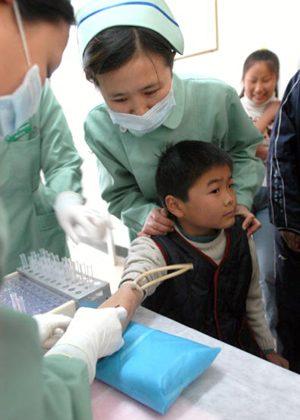BEIJING - China’s Minister of Health Gao Qiang said in a press conference in late November that China plans to curb the growing number of its people infected with HIV to 1.5 million by the year 2010. Officials at the World Health Organization (WHO) however predict that the number of HIV infections will grow to the tens of millions by 2010 unless measures are implemented to hinder its spread, reports The New York Times , quoting a senior official from WHO. Independent observers believe that nine out of ten HIV-infected people in China are not even aware of being infected.
China’s Official Figures Differ Substantially from United Nations’ Estimates
According to figures released by Chinese authorities, the current number of Chinese people infected with HIV is about 840,000. Among them, about 80,000 people have developed AIDS. However, the Joint United Nations Program on HIV/AIDS estimates that the actual number of those living with HIV is between 430,000 and 1,500,000.
The statistics revealed by Xinhua.net, the website of Xinhua , the Chinese Communist Party’s official information outlet, also indicate that as of the end of September 2005, five provinces and/or autonomous regions in China, Xinjiang, Henan, Yunnan, Guangdong and Guangxi, each had more than 10,000 HIV-infected residents.
According to a report by the China News Service , in Yunnan Province, the regional total cases of HIV infection has reached 37,000. Yunnan is the hardest hit by HIV. Even these numbers are low due to under-reporting because of social stigma.
According to China’s Deputy Minister of Health, Wang Longde, who also heads the HIV/AIDS Prevention and Control Commission under China’s State Department, HIV is now spreading from high-risk groups to the larger public. He said that China is now at the critical moment, where it absolutely must take action to confine the spread of HIV. What’s more, The New York Times , reports that the verified cases of HIV infection in China probably represent only a small portion of the actual total, considering China’s broad territory and laggard medical system.
Dr. Bates Gill of the Center for Strategic and International Studies pointed out that although the HIV infection cases released by the Chinese officials amount to 840,000, there are far more people who are not aware that they have contracted HIV. Regardless of what the precise number might be, these unidentified HIV infections have obvious implications for the continued spread of the disease in China.
“What I’m saying is that nine out of 10 people or so in China today, according to the government’s own statistics, who are HIV positive don’t know it,” said Gates. “And the government doesn’t know who they are or where they are.”
Prevalent Infection of Transient Youth
According to a report by the China Sexology Association, the registered number of HIV infections in Beijing at the end of May 2005 totaled 2,145 cases, ranking number seven nationwide. The data also showed the percentage of infection in the transient youth population is significantly higher than the indigenous residents, signaling the looming threat of HIV’s spread among the common people.
Zhang Konglai, a professor of the Peking Union Medical College, who also serves as the Vice President of the Chinese Association of STD (sexual transmitted diseases) & AIDS Prevention and Control, highlighted the importance of promoting the use of condoms in sexual behaviors to reduce the transmission of AIDS and other sexually transmitted diseases.
Professor Zhang said, “Youthful transience is a critical risk factor, because these young people constantly move from one place to another. Some of them are single, while the others are married without living together with their family. Under such circumstances, their sexual needs may be met through unsafe routes.”
